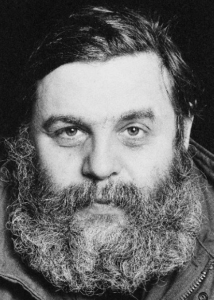 A.R. Penck, alias of Ralf Winkler born 1939 in Dresden, Germany; he died in 2017. Penck is a neo-expressionist painter, sculptor, and jazz drummer A.R. Penck died 2017.
A.R. Penck, alias of Ralf Winkler born 1939 in Dresden, Germany; he died in 2017. Penck is a neo-expressionist painter, sculptor, and jazz drummer A.R. Penck died 2017.
Penck never formally studied art, but learned from the art masters. In 1954 he joined the artist group First Phalanx Nedserd. The group sought artistic work without compromise. For this reason, the members of the artist group were denied academic studies. An autodidact, he created in his paintings, “worlds” and “experience spaces”, filled with symbolic abbreviations. He used stick figures and graphic icons that seem reminiscent of cave paintings, Asian calligraphy and graffiti art. In the 1960s and 1970s, he created a series of paintings and sculptures, that he called Standart, a conflation of standard and “art”, with an echo of the German word for banner or flag, Standarte. By this term, Penck understood an art form that used simple and archaic pictorial symbols, such as traffic signs or trademarks.
In 1966, Winkler became a candidate of the Association of Plastic Artists, now under the pseudonym A. R. Penck, which was chosen after the geologist and ice age researcher Albrecht Penck. Since 1969, he got increasingly problems with the Ministry of State Security of the GDR: Pencks pictures were confiscated, his membership in the Association of Visual Artists of the GDR (VBK) was rejected.
Winkler founded in 1971, together with Steffen Terk, Wolfgang Opitz and Harald Gallasch, the artist group LÜCKE (gap), which existed until 1976. From 1973 on he worked with the alias Mike Hammer and T.M, from 1976 he signed also with Y. After military service in 1974 and above all the awarding of the Will Grohmann Prize in 1975 by the Academy of Arts in West Berlin, the state security controls also increased. In 1976 Penck met the West German painter Jörg Immendorff, with whom he collaborated for the following years. In their work, they campaigned for both the abolition of the German-German border and for dissidents, including Rudolf Bahro and Robert Havemann. 1977, the customs confiscated his paintings.
In the 1980s he became known worldwide for his paintings with pictographic, neo-primitivist imagery of human figures and other totemic forms. He was included in many important shows both in London and New York City. Even his paintings seem to be similar to Keith Haring, Penck considered his work more akin to Ernst Ludwig Kirchner, Paul Klee, late Jackson Pollock, or his other love—jazz music. He was also co-founder of the free jazz group Triple Trip Touch. Like his fellows Georg Baselitz and Jörg Immendorff, he had investigated the relationship between neo-primitivist figuration and abstraction, between personal and universal mythologies.
